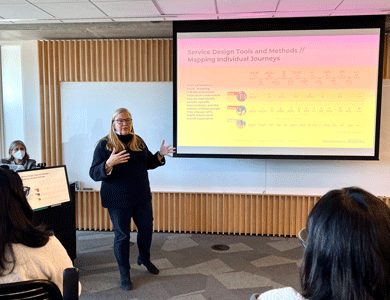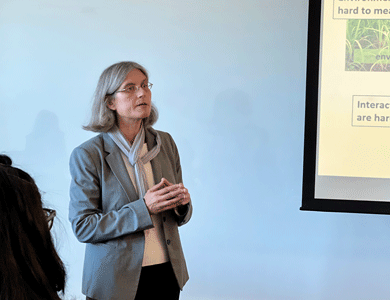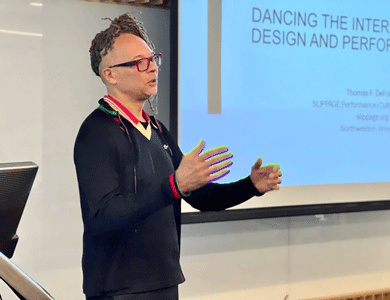Exploring the Intersections of Design, Neuroscience, and Dance
Design at the Intersections workshops explored design, neuroscience and biomedical engineering, and improvisational dance performance
By discovering the overlaps between design and engineering processes, the Design at the Intersections series — hosted by the Segal Design Institute — seeks to spark interdisciplinary connections across Northwestern Engineering and expand the possibilities of design and engineering research.
The final talks in the series, held on October 26 and November 7 in the Ford Engineering Design Center Hive Annex, encouraged participants to consider how design intersects with neuroscience and biomedical engineering, and improvisational dance performance.
Michael Peshkin, professor of mechanical engineering, Breed Senior Professor of Design, and organizer of the Design at the Intersections series, welcomed the guests and introduced the speakers.
Complex Ecosystems
Mitra Hartmann and Amy O’Keefe’s talk “Complex Ecosystems” on October 26 began with an activity O’Keefe said “might make you uncomfortable.”
They asked the participants to introduce themselves to an unfamiliar person in the room and to find something in common with the other person. The pairs were then asked to share their commonality with the rest of the group.
 The exercise, which helped participants understand the challenge of finding overlaps and intersections with new people and ideas, set the stage for Hartmann and O’Keefe’s lecture: an exercise in finding the intersection between Hartmann and O’Keefe’s work.
The exercise, which helped participants understand the challenge of finding overlaps and intersections with new people and ideas, set the stage for Hartmann and O’Keefe’s lecture: an exercise in finding the intersection between Hartmann and O’Keefe’s work.
Hartmann is a professor of mechanical engineering and biomedical engineering, and is a member of the Center for Robotics and Biosystems. Her research and SeNSE lab revolves around understanding how animals and humans sense and perceive the world around them. She’s particularly interested in touch, and her lab uses the rodent whisker system to understand how whiskers communicate touch to the brain.
O’Keefe is the director of the Master of Science in Engineering Design Innovation program and is a clinical assistant professor at the Segal Design Institute. She leads the Human-Centered Service Design Studio, where she helps students explore the nature of “service ecologies” or a set of actors (people and interactive products) and the relationships between them. She has led teams that designed services ranging from helping people access rescued charitable food through Feeding America to going to college with a disability with Northwestern’s Center for Food Allergy and Asthma Research (CFAAR).
 Though their disciplines may seem different, Hartmann and O’Keefe shared they have a common goal of exploring, understanding, quantifying, and designing ecologies that exist in nature and in the physical and digital environments people navigate each day.
Though their disciplines may seem different, Hartmann and O’Keefe shared they have a common goal of exploring, understanding, quantifying, and designing ecologies that exist in nature and in the physical and digital environments people navigate each day.
They also found that a loop model, the Environment-Individual-Collective-Action (EICA) Loop, can describe an important process that they both consider in their work.
For instance, if a service is started on a college campus to accommodate students with food allergies, the EICA loop would include:
- the environment, composed of the campus, dorms, dining, halls, and events at the college
- the individual student experiences of that process on campus
- the collective experience of stakeholders including students, roommates, cafeteria workers, staff, faculty, and custodians
- actions taken by different community members
Each part of the EICA loop, Hartmann said, is hard to model and has its own complexity. Each element, and the loop itself, evolves at many different times and faces external pressures happening simultaneously. The collective experience, or the engagement of multiple stakeholders throughout the loop, determines the success or failure of the service. In the field of neuroscience, the loop involves an animal’s environment, individual sensors, collections of neurons, and muscles, all of which co-evolve to determine the success of the species.
Dancing the Interface
The beginning of Thomas DeFrantz’s talk “Dancing at the Interface” on November 7 started aptly with an improvised dance performance by DeFrantz. While waving a Nintendo Wii video game controller in his right hand, he swayed, bounced, and lunged across the room to a series of energetic, electronic sounds.
The dance was a demonstration of DeFrantz’s work and the topic of his talk, which discussed how physical movement relates to data stored and manipulated by electric charges.
DeFrantz is the director of SLIPPAGE: Performance|Culture|Technology, a performance research group in residence at MIT from 2003 to 2011, then at Duke University, and newly installed at the Segal Design Institute. Through his lab, DeFrantz explores emerging technology in live performance applications.
 Dance improvisers who use technology and computer interfaces in their craft are faced with many challenges, DeFrantz said. They never really know if the machines will work or not. They also “endure overwhelming senses of non-empathetic indifference to questions of social identity that provide the warp and the whoof of physical imagination.”
Dance improvisers who use technology and computer interfaces in their craft are faced with many challenges, DeFrantz said. They never really know if the machines will work or not. They also “endure overwhelming senses of non-empathetic indifference to questions of social identity that provide the warp and the whoof of physical imagination.”
DeFrantz explored these questions through a series of case studies, including DSGN 395: Performance and Technology, a class he started teaching at the Segal Design Institute last spring. In the course, students studied the theme of “butterfly effect,” working to show how small changes can produce a bigger change through technologically enhanced, movement-based performances.
In class, the students were driven by an ethical and value system that DeFrantz brings to his work and that is embodied by the SLIPPAGE lab: namely, a system that values a collective good that is anti-racist, proto-feminist, and queer affirming.
“As the students enter this question of performance and technology and design in relationship to interface, we start there,” DeFrantz said. “We’re going to begin with this value system and try to work toward it. It doesn’t mean we get there every time or every day. It doesn’t mean we know how to do that. But it means that we’re actually aware of the possibility of the potential to move in these directions, even as we’re designing and working as engineers or performers.”
Moving in the direction of these values, DeFrantz said he uses improvisational movement to combine “lingering questions about race, class, gender, and sexuality with the choices of the moment.” His ultimate goal as an improviser, he said, is to engage and model social flexibility as a mode of artmaking. At SLIPPAGE, that included performances that use archives of digital sound and video manipulated in response to physical gestures of the performer.
Examples DeFrantz shared included performances that explored the afterlives of slavery, empathy, the hauntings of violence, and the emergence of house music. During the performances, computer interfaces were used to project images onto screens in response to performers’ movements and produced audio in response to the performers’ sounds and movements.
“Improvising dance in these interfaces, and according to our agreed on narrative constraints, I often thought of the engineers, the technologists, the researchers, and the collaborating designers,” DeFrantz said. “As I attempted to manipulate a tone using the miditron or stretch the face of a young woman with the Wii controller, by themselves these interfaces seldom allowed for the park of empathetic recognition, as another improvising performer might have done. In the end, these human relationships and all the missteps and accomplishments that led us toward performance were the material that fed my ability to compose while dancing.”
